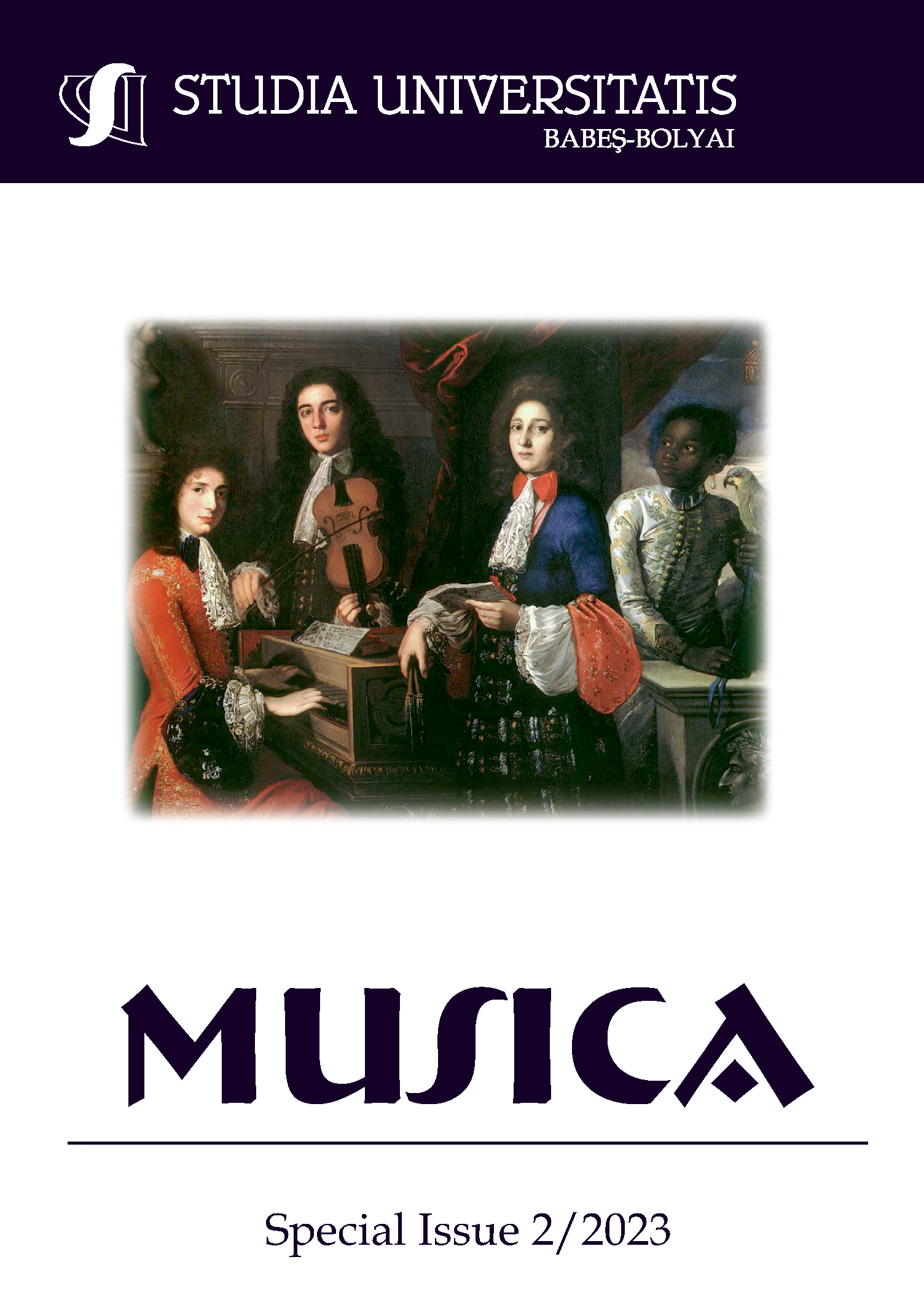EXPLORING CHINESE CULTURAL IDENTITY IN THE LIANG ZHU VIOLIN CONCERTO: AN INTERCULTURAL PERSPECTIVE ON THE ADAPTATION OF TRADITIONAL ELEMENTS IN WESTERN CLASSICAL MUSIC LANGUAGE
DOI:
https://doi.org/10.24193/subbmusica.2023.spiss2.22Keywords:
Interculturality, Liang Zhu, Identity, Imitation.Abstract
This article examines the phenomenon of interculturality through the lens of the Liang Zhu Concerto for Violin and Orchestra by He Zhanhao and Chen Gang. Interculturality is no longer merely a means of elevating the axiological value of a given context but has become a necessity for authenticating contemporary discourse. The role of interculturality in shaping the expression of creative intentions is amplified, as it attenuates divergences determined by the incongruity of individuals’ backgrounds by comprehensively observing the uniqueness of foreign elements from a familiarity-based perspective. The Liang Zhu Violin Concerto exemplifies the adaptation of East Asian culture to the context of the Western language and means of expression while preserving its Chinese cultural identity. This concerto has significant value and desirability for consumption due to the proportion of originality and familiarity which it upholds and determines its overall appeal. Ultimately, this article aims to explore how the Liang Zhu Violin Concerto achieves originality at a global level while preserving its Chinese cultural identity.
References
“Ba Jin | Chinese Author.” Encyclopædia Britannica, https://www.britannica.com/biography/Ba-Jin. (Accessed 22 February 2022)
Cho, Sookja. “Within and Between Cultures: The Liang-Zhu Narrative in Local Korean Cultures.” Harvard Journal of Asiatic Studies, vol. 74, no. 2, 2014, pp. 207–48, JSTOR, doi:10.1353/jas.2014.0022.
Chao, Min-Tzu. “Interpretation and Expressive Imagery in The Butterfly Lovers Violin Concerto on Double Bass: Transcribed by Yung-Chiao Wei.” LSU Doctoral Dissertations, 2011, 1807. digitalcommons.lsu.edu/gradschool_dissertations/1807.
Chao, Han-yang. The Five Hundred Questions and Answers of the Art of Erhu Playing. People’s Music Publishing House, 2005.
“Chen: The Butterfly Lovers’ Concerto.” Gramophone, 19 Aug. 2019, https://www.gramophone.co.uk/review/chen-the-butterfly-lovers-concerto. (Accessed 21 February 2022)
Chen, Gang. “The Butterflies Are Free.” Wen Hui Press, 2003.
Finchum-Sung, Hilary Vanessa. “Foreword: Aesthetics of Interculturality in East Asian Contemporary Music.” The World of Music, vol. 6, no. 1, 2017, pp. 7–20. JSTOR, doi:10.2307/44841967.
“Chen Gang.” University of Southern California - Thornton School of Music, archived at https://archive.ph/20121215143408/http://www-rcf.usc.edu/~echew/projects/ChineseMusic/composers/chen_gang.html. (Accessed 22 February 2022)
Fu, Hua-gen. The Interpretation of Erhu Playing. Edited by Irene Y. Chen, International Publishing House for China’s Culture, 2006.
Fung, Chi-Keung Victor. “Music and Culture: A Chinese Perspective.” Philosophy of Music Education Review, vol. 2, no. 1, 1994, pp. 47–52. JSTOR, doi:10.2307/40327069.
“Huqin | Musical Instrument.” Encyclopædia Britannica, https://www.britannica.com/art/huqin. (Accessed 22 February 2022)
Jiang, Yuli. “The Chinese violin concerto The Butterfly Lovers by He Zhanhao (1933) and Chen Gang (1935) for violin and orchestra.” ProQuest Dissertations Publishing, 2004. 3128861. https://www.proquest.com/openview/c62a3ed076d4fe3b13dc26b0f3a0eb8d/1?pq-origsite=gscholar&cbl=18750&diss=y.
Jing, Jiang. “The Influence of Traditional Chinese Music on Professional Instrumental Composition.” Asian Music, vol. 22, no. 2, University of Texas Press, 1991, pp. 83–96, doi:10.2307/834308.
Lau, Frederick. Music in China: Experiencing Music, Expressing Culture. Oxford University Press, 2008.
Leiter, S. L. “Review of Chinese Opera: Images and Stories; Peking Opera, by S. Wang-Ngai, P. Lovrick, & C. Mackerras.” Asian Theatre Journal, vol. 16, no. 1, 1999, pp. 129-132, http://www.jstor.org/stable/1124451.
Miller, Richard C., and Yayoi Uno Everett. “Locating East Asia in Western Art Music.” Music Theory Spectrum, vol. 28, no. 1, Oxford University Press, Society for Music Theory, 2006, pp. 127–31, doi: 10.1525/mts.2006.28.1.127.
Shan-Ken, Chien. “The ‘Butterfly Lovers’ Violin Concerto’ by Zhanhao He and Gang Chen.” 2014, https://core.ac.uk/download/pdf/213407121.pdf.
Xu, Lanjun. “The Lure of Sadness: The Fever of ‘Yueju’ and ‘The Butterfly Lovers’ in the Early PRC.” Asian Theatre Journal, vol. 33, no. 1, 2016, pp. 104–29, http://www.jstor.org/stable/24737158.
Yang, Hon-Lun, and Michael Saffle, editors. China and the West: Music, Representation, and Reception. University of Michigan Press, 2017, doi: 10.2307/j.ctt1qv5n9n.
“Yangqin | Musical Instrument.” Encyclopædia Britannica, https://www.britannica.com/art/yangqin. (Accessed 22 February 2022)
Yayoi, Uno E. and Frederick Lau. Locating East Asia in Western Art Music. Wesleyan University Press, 2004.
Zhang, Ying. “The Butterfly Lovers’ Violin Concerto (1959).” 2021. UNLV Theses, Dissertations, Professional Papers, and Capstones, paper 4273.
https://digitalscholarship.unlv.edu/thesesdissertations/4273.
Downloads
Published
How to Cite
Issue
Section
License
Copyright (c) 2023 Studia Universitatis Babeș-Bolyai Musica

This work is licensed under a Creative Commons Attribution-NonCommercial-NoDerivatives 4.0 International License.






